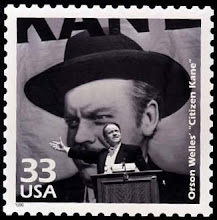She was the perfect movie wife: smart, snarky, long-suffering but rarely
suffering foolishness. She had an
effortless upper-crust style but looked right at home slumming with the
rabble. She was sexy but not showy,
playful but demure, usually one step ahead of her male counterpart but never
feeling the need to prove it. She was a
great actress but never the one to carry a vehicle the way a Davis or Crawford
or Stanwyck or Dietrich or Garbo or Garson did.
She was the perfect complement to her leading man, both the sizzle and
the steak. You could say that Myrna Loy,
who died on this date 20 years ago, was pigeon-holed as the ideal partner,
fiercely independent in spirit but never really alone, and maybe that kept her
away from roles that brought attention to her chops. She was never nominated for an Oscar or
Golden Globe or received any award from a critics group until the Lifetime
Achievement accolades finally came, decades after her best parts were behind
her.
You could say that the pivot point was The Thin Man (Van Dyke,
1934). Because before that, she was typecast
as the jazz-age vamp, the sultry femme fatale or the “Asian” bad girl, but most
of these films (many of them silent) are either lost or largely unknown. In my favorite film of hers, Rouben
Mamoulian’s brilliant Love Me Tonight (1932), she’s a sexually voracious
debutante stealing every scene she’s in—lusty, hilarious and irresistible. But Nora Charles would cement how we see her
now.
Like most film series, The Thin Man movies suffer from the law of
diminishing returns, with each subsequent installment priceless in the repartee
she had with William Powell but fairly interchangeable when it came to the
plots and culprits. In fact, she made 8
other films with Powell and I prefer quite a few of them more than the other
Nick & Nora adventures—testimony to how it wasn’t just the conceit of the
mysteries that held those films together, but their boundless chemistry (along
with Asta, the greatest dog comic in cinema history).
Perhaps my favorite two Thin Man films outside the original are also
ones that have postage stamp references.
The Thin Man Goes Home (Thorpe, 1944) has Nick & Nora return to
Nick’s hometown and disapproving father (a very funny Harry Davenport), only to
get caught up in international intrigue.
In the climax, we learn that the villain is Lloyd Corrigan, who actually
committed the murder in question instead of spending time with his stamp
collection, which he had used as an alibi.
I’m guessing he probably does have a stamp collection (who would lie
about that?) so chalk that up as another Evil Philatelist, a fun cinematic
sub-genre I’ve mentioned before. This is
also the installment where Loy has the most to do, since Nick’s reluctance to
take on the case means Nora’s intrepid nosiness proves critical in assembling
some vital clues. And legendary
character actresses Anne Revere and Lucile Watson show up for good measure.
In Shadow of the Thin Man (Van Dyke, 1941), Nick looks into the death of
a jockey at a racetrack. In one scene,
reporter (and friend of the Charles’) Barry Nelson is found rummaging through
the office of a gambling boss and hood Alan Baxter confronts him by saying,
“What were you looking for, a stamp?” It
doesn’t take long before Baxter is also dead and Nelson framed for his
murder.
I like this film because it
takes place in the SF Bay Area—the racetrack scenes were shot at Golden Gate Fields
in Berkeley (which I pass every day going to work), and the film includes a
scene where Nick is pulled over for speeding on the Oakland Bay Bridge, back
when you could drive east-bound on the upper deck (long before The Graduate
made such a commute a glaring continuity error). And it has a priceless setpiece where Nick
& Nora attend a pro wrestling match.
That, and Nick Jr. (their son, introduced in the prior Another Thin Man)
is cute enough without suffering from Cousin Oliver syndrome.
Neither Loy nor Powell have US postage stamps. In fact, the only person to be honored with a stamp to appear in the series is Jimmy Stewart, who played a very atypical role in the second installment, After the Thin Man.
Favorite Myrna Loy and/or William Powell films (all films cited
feature both except * = Loy, + = Powell)
- Love Me Tonight (Mamoulian, 1932) *
- The Best Years of Our Lives (Wyler, 1946) *
- The Thin Man (Van Dyke, 1934)
- One Way Passage (Garnett, 1932) +
- Double Wedding (Thorpe, 1937)
- Libeled Lady (Conway, 1936)
- I Love You Again (Van Dyke, 1940)
- Love Crazy (Conway, 1941)
- Mister Roberts (Ford/LeRoy, 1955) +
- A Girl in Every Port (Hawks, 1928) *




No comments:
Post a Comment